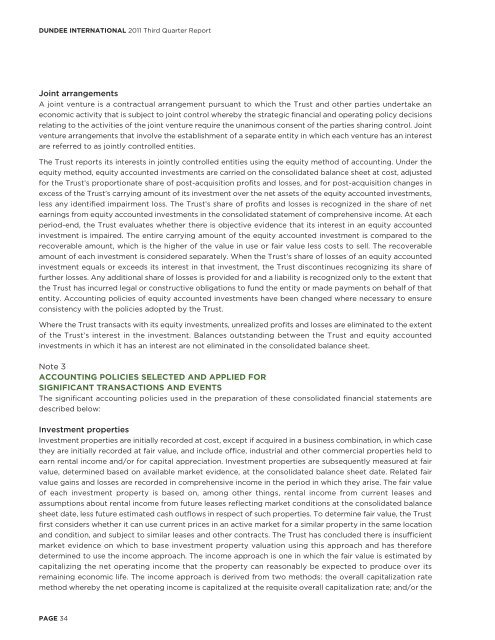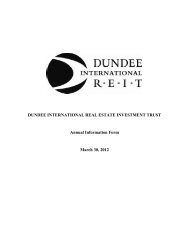DUNDEE INTERNATIONAL REIT
DUNDEE INTERNATIONAL REIT
DUNDEE INTERNATIONAL REIT
You also want an ePaper? Increase the reach of your titles
YUMPU automatically turns print PDFs into web optimized ePapers that Google loves.
<strong>DUNDEE</strong> <strong>INTERNATIONAL</strong> 2011 Third Quarter Report<br />
Joint arrangements<br />
A joint venture is a contractual arrangement pursuant to which the Trust and other parties undertake an<br />
economic activity that is subject to joint control whereby the strategic financial and operating policy decisions<br />
relating to the activities of the joint venture require the unanimous consent of the parties sharing control. Joint<br />
venture arrangements that involve the establishment of a separate entity in which each venture has an interest<br />
are referred to as jointly controlled entities.<br />
The Trust reports its interests in jointly controlled entities using the equity method of accounting. Under the<br />
equity method, equity accounted investments are carried on the consolidated balance sheet at cost, adjusted<br />
for the Trust’s proportionate share of post-acquisition profits and losses, and for post-acquisition changes in<br />
excess of the Trust’s carrying amount of its investment over the net assets of the equity accounted investments,<br />
less any identified impairment loss. The Trust’s share of profits and losses is recognized in the share of net<br />
earnings from equity accounted investments in the consolidated statement of comprehensive income. At each<br />
period-end, the Trust evaluates whether there is objective evidence that its interest in an equity accounted<br />
investment is impaired. The entire carrying amount of the equity accounted investment is compared to the<br />
recoverable amount, which is the higher of the value in use or fair value less costs to sell. The recoverable<br />
amount of each investment is considered separately. When the Trust’s share of losses of an equity accounted<br />
investment equals or exceeds its interest in that investment, the Trust discontinues recognizing its share of<br />
further losses. Any additional share of losses is provided for and a liability is recognized only to the extent that<br />
the Trust has incurred legal or constructive obligations to fund the entity or made payments on behalf of that<br />
entity. Accounting policies of equity accounted investments have been changed where necessary to ensure<br />
consistency with the policies adopted by the Trust.<br />
Where the Trust transacts with its equity investments, unrealized profits and losses are eliminated to the extent<br />
of the Trust’s interest in the investment. Balances outstanding between the Trust and equity accounted<br />
investments in which it has an interest are not eliminated in the consolidated balance sheet.<br />
Note 3<br />
ACCOUNTING POLICIES SELECTED AND APPLIED FOR<br />
SIGNIFICANT TRANSACTIONS AND EVENTS<br />
The significant accounting policies used in the preparation of these consolidated financial statements are<br />
described below:<br />
Investment properties<br />
Investment properties are initially recorded at cost, except if acquired in a business combination, in which case<br />
they are initially recorded at fair value, and include office, industrial and other commercial properties held to<br />
earn rental income and/or for capital appreciation. Investment properties are subsequently measured at fair<br />
value, determined based on available market evidence, at the consolidated balance sheet date. Related fair<br />
value gains and losses are recorded in comprehensive income in the period in which they arise. The fair value<br />
of each investment property is based on, among other things, rental income from current leases and<br />
assumptions about rental income from future leases reflecting market conditions at the consolidated balance<br />
sheet date, less future estimated cash outflows in respect of such properties. To determine fair value, the Trust<br />
first considers whether it can use current prices in an active market for a similar property in the same location<br />
and condition, and subject to similar leases and other contracts. The Trust has concluded there is insufficient<br />
market evidence on which to base investment property valuation using this approach and has therefore<br />
determined to use the income approach. The income approach is one in which the fair value is estimated by<br />
capitalizing the net operating income that the property can reasonably be expected to produce over its<br />
remaining economic life. The income approach is derived from two methods: the overall capitalization rate<br />
method whereby the net operating income is capitalized at the requisite overall capitalization rate; and/or the<br />
PAGE 34






